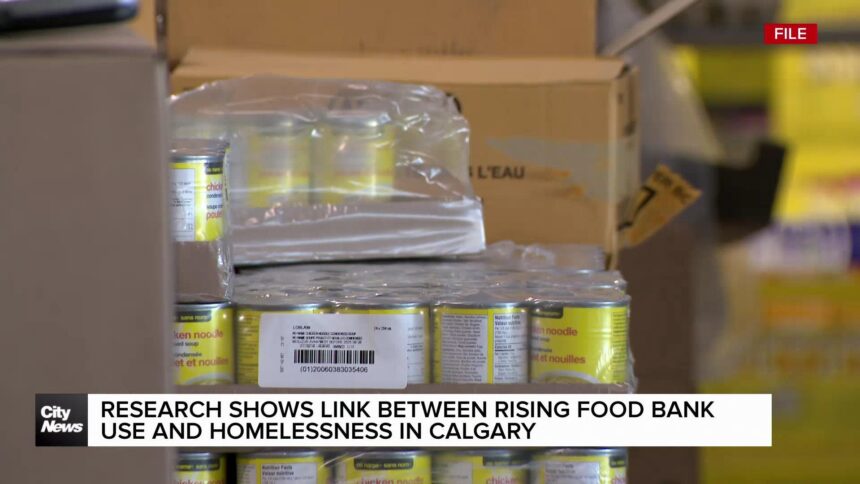A groundbreaking study released yesterday by the Calgary Homelessness Foundation paints a troubling picture of the connection between food insecurity and housing instability in Alberta’s largest city. The research, conducted over 18 months, reveals that nearly 40% of consistent food bank users report experiencing housing precarity within six months of their initial visit.
Standing outside the Downtown Calgary Food Bank on a chilly June morning, I watched as the line stretched around the block before opening hours. Melissa Thornton, a single mother of two, shared her story while waiting. “First it was just struggling to buy groceries after rent went up. Now we’re staying with my sister because we got evicted last month,” she told me, her voice steady despite the circumstances.
Thornton’s experience mirrors the findings in the new study, which suggests food bank dependency often serves as an early warning sign for impending homelessness. The research tracked 2,400 Calgary households between January 2024 and May 2025.
“What we’re seeing is a domino effect,” explains Dr. James Morrison, lead researcher at the Calgary Homelessness Foundation. “When families need to choose between food and rent, they often try to maintain housing as long as possible while compromising on nutrition. Eventually, both become unsustainable.”
The data reveals a startling 27% increase in first-time food bank users across Calgary since last year. More concerning, the typical progression from occasional food support to housing loss has accelerated from approximately nine months in 2023 to just under six months today.
Calgary Mayor Jyoti Gondek addressed these findings at yesterday’s press conference, calling for coordinated intervention. “This research confirms what our community partners have been telling us anecdotally. We need to view food security and housing stability as interconnected issues requiring immediate attention.”
The provincial response has been more measured. Alberta Minister of Community and Social Services Jason Nixon issued a statement acknowledging the research while emphasizing existing programs. “Our government continues to invest in affordable housing initiatives across the province while working with community partners to address immediate needs,” the statement read.
Critics, including the Alberta Housing Coalition, argue the provincial response falls short. “We’ve seen a 14% cut to housing support programs since 2022, while demand has increased by nearly 30%,” notes Coalition Director Sandra Williams. “The math simply doesn’t add up.”
At the Bowness Community Food Pantry, volunteer coordinator Robert Chang shows me their increasingly bare shelves. “Three years ago, we served maybe 75 families weekly. Now it’s over 200, and we’re turning people away,” Chang explains while organizing donations. “Many of our regulars have simply disappeared from our roster. When we follow up, we often learn they’ve lost housing altogether.”
The study identifies several critical factors contributing to this acceleration, including Calgary’s rental market experiencing a 19% increase in average rents since 2023. Meanwhile, inflation-adjusted social assistance rates have declined by 3.8% in real purchasing power over the same period.
For perspective, a family of four receiving maximum benefits can access approximately $2,450 monthly through combined provincial programs. The average two-bedroom apartment in Calgary now costs $1,850 monthly according to the Canada Mortgage and Housing Corporation’s latest rental market report.
“The math becomes impossible,” explains University of Calgary economics professor Dr. Elena Mikhailova. “When housing consumes 75% of your income, any unexpected expense—a car repair, medical need, or school expense—creates an immediate crisis.”
The report recommends several immediate interventions, including expanding rental supplements, increasing food bank capacity, and creating early intervention programs that identify at-risk households before housing loss occurs.
Calgary Housing Director Thomas Wilson confirms the city is already implementing some recommendations. “We’ve launched a pilot program that connects food bank users with housing support workers during their visits,” Wilson told me. “Early results show we can often stabilize housing situations with relatively modest one-time assistance averaging $800 per household.”
Food Banks Canada spokesperson Jennifer Liu describes Calgary’s situation as particularly acute but not unique. “We’re seeing similar patterns emerge in cities across Canada where housing costs have outpaced income growth,” Liu explains. “Food banks were never designed to be permanent infrastructure, yet they’ve become essential lifelines in communities nationwide.”
Back at the Downtown Calgary Food Bank, operations manager Dave Kowalski shows me their new intake form, which now includes housing stability questions. “We’re trying to identify people at risk before they reach crisis,” Kowalski explains. “Sometimes it’s as simple as helping someone navigate rental assistance programs they didn’t know existed.”
As I prepare to leave, I notice Melissa Thornton receiving her food hamper. She’s also speaking with a housing support worker, part of the new intervention program. There’s a glimmer of hope in her expression that wasn’t there earlier.
For thousands of Calgarians caught between hunger and homelessness, studies like this one matter beyond academic interest. They represent the first step toward solutions that recognize the complex reality of poverty—where food insecurity and housing instability aren’t separate issues but deeply interconnected challenges requiring coordinated response.
The full study is available on the Calgary Homelessness Foundation website, with community forums planned throughout the summer to discuss implementation strategies.






